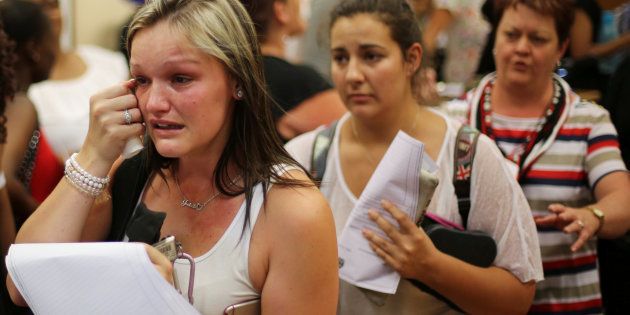
South African higher education is still in crisis. Exactly one year on from the original #FeesMustFall protests, we're back at it again. We're long on criticism and short on solutions. If something radical isn't done, in all likelihood we'll be back in the same place next year.
These protests are significant because higher education is essential to transformation and social mobility. There's a lot at stake. Many current and potential students face exclusion from higher education, employment, and ultimately, a comfortable middle class life because of unaffordable fees and outdated modes of education.
This crisis compelled us to start the Umuzi Academy. Since 2014, we have grappled with the problem of how to provide access to quality, creative education to ensure young people can start meaningful careers in the creative sector, and have the opportunity for social mobility. We've found that with the right principles, higher education can be delivered efficiently and effectively without public funding, in partnership between employers and a non-government institution, like our own.
Pretoria, we have a problem
The creative sector has specific hiring needs, served by a small number of dedicated private higher education institutions. Companies such as Red&Yellow, AAA, and Vega charge tuition of R60,000 to R100,000 per year, for their courses. This is an insurmountable hurdle for the majority of South Africans. To afford three or four years of this kind of tuition, let alone additional living expenses, you have to come from an upper income family. A visit to the parking lots of these institutions reveals there are South Africans who can afford this, and a German-manufactured first car to boot. Unfortunately, not enough of these students are black. And as a result, the creative departments of advertising agencies in Jo'burg, and especially Cape Town, are full of young people sporting a diversity of hair-styles and fashion, but, apart from the tattoos, their skin tones are uniformly light.
At its worse, the creative process within South African advertising agencies can resemble a parody from the hit series, Mad Men: debonair 1950's male advertising execs puff away on cigarettes, quaff scotch, and make sexist jokes about their secretaries, to come up with the next pantyhose commercial
The industry knows it has a problem. Talk to any advertising business or creative leader and they will tell you transformation of their creative staff is a high priority. On the business side, HR departments are increasingly concerned about how they will reach the B-BBEE targets laid out earlier this year in the MAC charter. They say there simply aren't enough qualified young black creatives to hire. The result is a bidding war for the limited black talent that exists, usually won by the biggest, international agencies, at the expense of the independent, local ones.
For the creatives, there's the ongoing challenge of trying to produced advertising that's authentic and resonates with a target market not well represented in the client briefings, brainstorms, and reviews necessary to produce good advertising. At its worse, the creative process within South African advertising agencies can resemble a parody from the hit series, Mad Men: debonair 1950's male advertising execs puff away on cigarettes, quaff scotch, and make sexist jokes about their secretaries, to come up with the next pantyhose commercial. You can imagine your own, South African version of this for Mayo and Zambuck.
How do we solve this problem?
Since 2014, the Creative Circle, the industry body representing advertising agencies, and Investec, has worked with the Umuzi Academy to solve this transformation challenge through improving access to creative higher education. The Umuzi Academy develops the next generation of creative professionals. Our one-year learnership prepares aspiring creatives from township communities to be employable in the creative sector as art directors, graphic designers, copywriters, multimedia, and digital junior professionals.
Here's what we've learned building an alternative to traditional higher education:
Don't pay to study, get paid to learn
Yes, fees must fall. But even that's not enough. If young people are paid to learn, and treated like employees, they perform better than if they are treated as "students".
The B-BBEE legislature incentivises companies to invest in skills development for unemployed youth. With skills development funding from Investec and creative agencies, Umuzi runs as a sustainable not-for-profit organisation offering free tuition, and a stipend of R1,500 per month to support these young people to learn.
Traditional higher education has an appalling 50% dropout rate in the first year. In Umuzi's most recent graduation, 58 out of 61 completed the programme. The three "drop-outs" left for funded graduate education or full-time employment.
Burn the textbooks and train on-the-job
Umuzi has experimented with various modes of learning, and by far the most effective has been on-the-job training. Umuzi runs like an advertising agency, working in a large open-plan studio in Jeppestown, Johannesburg. We don't employ educators. Instead, we hire experienced, senior creatives, from leading agencies, to manage and mentor the recruits to do real work. Briefs come from clients, community-based organisations, and through partnerships with traditional advertising agencies. Agencies love collaborating with the young Umuzi recruits precisely because they don't have access to enough young, black talent in their own creative departments.
Don't define success as a certificate, get a job
As an MICT SETA registered training provider, Umuzi offers its graduates a National Certificate in Advertising. But that alone isn't nearly enough to get them a job. The learnership also includes six months of working in Umuzi's internal agency, and concludes with three months of work experience at a leading local or international creative agencies, made possible through the partnership with the Creative Circle. Umuzi defines success as the number of young people who manage to convert their work experience into a full-time job offer. In our most recent graduation, over 80% of graduates had already landed jobs, transforming their own lives, their families' futures, and the industry.
Is this privatisation? In a sense, it is. Thoughtful corporate skills development is funding an apprenticeship-style programme delivered by an independent non-government organisation. In a way, the structure doesn't matter. It's the principles that govern it. We hope to see the Umuzi Academy scale, as well as see more examples of successful programmes built on similar principles. If we don't, we risk #FeesMustFall becoming a recurring nightmare with escalating, broader social consequences, and an unaffordable slow down in transformation and social mobility.
